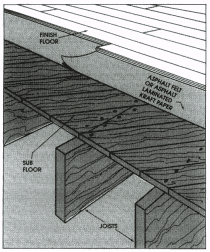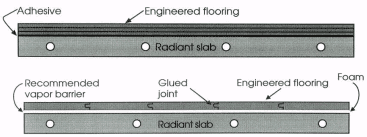|
Prefinished
|
Site Finished
|
| V-Joints |
Yes
– Required to hide minor height differences between the boards
– the most obvious difference between the two types of floors |
No (unless you want them)
– Any difference in height will be sanded out in the finishing process |
| Finish |
– Finished under ‘ideal’ conditions so no hair, dust etc in finish
– Sheens limited to those available
– Almost all brands will change colour with UV exposure
–
Most coatings have very hard particles (powder) embedded in them to
resist wear. These include Aluminum Oxide, Titanium Oxide and ceramic. |
– While we do make every effort to clean the floors we can miss a hair or piece of grit or dust
– Most brands of finish have several sheen levels available
– Streetshoe (our regular finish) has a UV inhibitor to greatly reduce colour change due to UV exposure
– Wearmax finish has both UV inhibitors and ceramic particles for extreme wear resistance |
| Colour |
– Factory applied colour stains are normally very even in colour
– Colours limited to those available |
– Site applied stains are prone to slight unevenness.
Very dark, very red and pastel colours are more likely to have this
problem.
– Virtually any colour is possible |
| Time Required |
– Faster completion time since no finishing is required. |
– Finishing will usually add 3 – 6 days to the installation time |
| Mess |
– While there is no fine sanding dust there is still some dust from the saws. |
– This is the reason most people choose prefinished
floors. The dust from sanding (buffing) is very fine and tends to find
its way into most areas of the site |
| Design Possibilities |
– There are now many species available in prefinished flooring
– Simple borders and inlays are possible |
– Every year there are more new species available and there are still more types and sizes of unfinished floors than prefinished
– The only limit to the design of a site-finished floor is your imagination (and maybe your budget?) |
| Clearing Space |
– We can work around a few large pieces or furniture |
– The whole area to be sanded has to be clear |
| Water Resistance |
– There is no difference. |
– NO, THE FINISH DOES NOT BRIDGE THE GAP BETWEEN THE BOARDS! It is not impervious to water penetration. |
|
Flooring Types
|
Solid T & G
|
Nail-down installation over wood subfloor
Made of a single piece of wood milled with an interlocking joint (Tongue & Groove) usually 3/4″ or 1/2″ thick. Most versatile type of flooring for custom detailing and species choice. |
|
Floating
|
Best used over concrete, but can be installed over any type of subfloor by gluing or clicking planks together over a cushioned vapour barrier.
|
|
Gluedown
|
Best used over concrete,
but can be nailed or glued to plywood / OSB. A multilayered engineered
flooring that comes as a single strip that is assembled in a manner
similar to plywood. The strips are glued or nailed down one by one
producing the look or a traditional solid wood floor.
|
The type of wood you use depends on the type of subfloor system that you have
Plywood on JoistMost common type of subfloor for single family homes with basement or
crawlspace. Suitable for all types of wood floor installations, but we usually recommend solid nail-down floors. |
 |
Concrete
Most common type of subfloor in newer condominiums and houses without basements or crawlspaces. Best suited to glue-down or floating installation of engineered wood floors. Radiant heated concrete has special warranty considerations.


